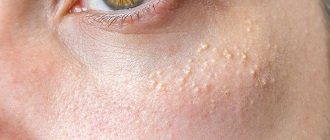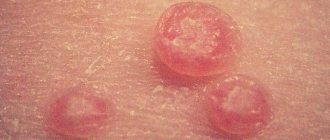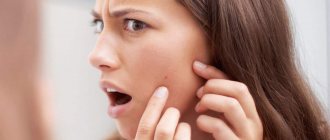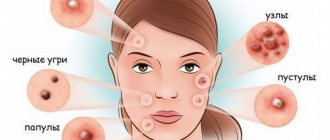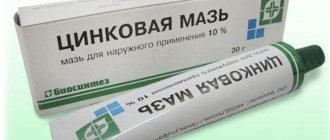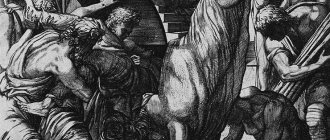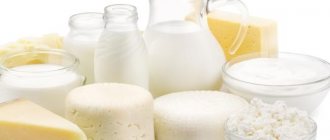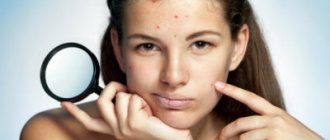What are acne
How to get rid of acne on your face?
The answer to this question will require a good knowledge of the “material parts”. Let's start with the theory. Acne (acne vulgaris, from the Greek akme - “top”) is a kind of plug formed from a mixture of sebum and keratinized skin particles accumulated in the sebaceous gland and its ducts. This plug serves as an excellent substrate for the growth of bacteria. Acne always appears against the background of hyperactivity of the sebaceous glands, but there are several other factors on which the status of this skin defect depends - whether it will be just an unesthetic, but generally harmless “black dot” or a full-fledged pimple filled with pus.
Causes and mechanisms
The skin reacts not only to external influences, but also changes under the influence of internal factors. It is one of the indicators of health, and therefore any dermatological problem requires attention. Dry acne on the face and body can have different origins:
- Acne (comedones).
- Atopic dermatitis (neurodermatitis).
- Follicular hyperkeratosis.
- Molluscum contagiosum.
The appearance of dry pimples is usually associated not with inflammation, but with other changes of a local or systemic nature. Among them, the following should be noted:
- Blockage of the ducts of the sebaceous glands.
- Allergic reactions.
- Hormonal imbalances.
- Deficiency of vitamins and microelements.
- Infectious diseases.
- Hereditary predisposition.
Sometimes dry pimples are mistaken for prickly heat, which occurs from skin irritation with physiological secretions, or simple warts - a consequence of infection with a virus. But in any case, you must consult a doctor to determine the cause of skin changes.
Causes and mechanisms
Dry skin and acne are incompatible concepts in the minds of many people who have not experienced it. However, people who suffer from acne with this type of skin know that this is quite possible. The main reasons why acne appears on dry facial skin are as follows:
- sensitive thinned dermis;
- allergic reaction;
- hormonal changes;
- poor nutrition;
- frequent stress;
- lack of vitamins;
- chronic pathologies.
If your skin is dry, acne may appear if the skin is frequently traumatized. Dry dermis is very sensitive and thinned, so the slightest irritation leads to inflammatory processes in it.
Both low and high ambient temperatures can cause an allergic reaction. People with dry and sensitive skin types often suffer from allergies to cold. But in hot weather, when excessive sweating is typical, a negative dermatological reaction to your own sweat, which contains harmful decay products, may occur. It causes local irritation, resulting in inflammatory processes in the epidermis.
Adolescence, pregnancy and menopause are periods during which a riot of hormones occurs in the body. Dramatic changes occur in all tissues. The dermis, in turn, can react with an inflammatory process. This phenomenon is also observed in chronic pathologies that affect the protective integument due to a decrease in the protective functions of the body.
Abuse of unhealthy foods leads to slagging in the body. Harmful substances are absorbed into the blood through the intestines and then delivered to the skin along with the bloodstream. The result is the occurrence of an inflammatory process in the epidermis, through the pores of which harmful substances leave the body.
Frequent stressful situations also lead to malfunctions of all organs, which leads to a dermatological problem.
Acne on the face with dry skin can also occur due to a deficiency of certain vitamins. Retinol, tocopherol, ascorbic acid, zinc, amino acids, and B vitamins are responsible for the health of the skin. A deficiency of one of the substances can lead to the onset of an inflammatory process in the dermis and a general deterioration in its appearance. Not only do rashes appear, but the skin begins to peel off severely.
Acne often appears on dry facial skin when the epidermis dies incorrectly and untimely. The patient may not properly care for the body or carry out cleansing activities. These types of acne love dry skin types. It is characterized by frequent peeling, redness and crusting.
Since the problem can arise due to improper care, it is very easy to deal with it: it is enough to scrub the skin in a timely manner and select the right moisturizer. These procedures must be performed constantly.
Dry scabs can also occur due to more important health problems. Allergic reactions, hormonal imbalances, problems with the endocrine or digestive system, gynecological diseases, etc. can provoke the appearance of formations.
With hormonal imbalances, a rash occurs. Dry pimples on the face appear on the skin; they practically do not differ in color from other areas of the skin. The size of such rashes is small. This symptom mainly affects women, because they experience hormonal imbalances.
Rashes may appear in allergy sufferers. They will definitely be accompanied by itching. If such a symptom occurs, you need to contact an allergist and take an antiallergic drug that will relieve itching and improve the condition.
If dry formations do not appear for the first time, and the cause of their occurrence is known, you do not need to consult a doctor. And if they appear for the first time, you first need to determine the cause of the allergy and limit contact with the allergen.
The condition of the skin depends on its type, nutrition, daily care and many other reasons. Among the internal factors that lead to dryness are:
- taking medications;
- poor nutrition;
- failure at the hormonal level;
- allergy;
- lack of vitamins and minerals in the body.
Low levels of vitamin A usually lead to a build-up of dead scales on the face, as well as skin inflammation in the form of pustules and pimples. Sometimes peeling is a normal reaction of the body to taking certain medications. After completing the course of treatment, the skin returns to normal. Malfunctions of the thyroid gland and the female reproductive system lead to hormonal imbalance, which immediately affects rashes on the face.
Often, the deterioration of the skin condition is caused by allergies, but it can be not only to food, pollen, but also due to unnatural cosmetics. In the case of high-quality cosmetics, skin care may be incorrectly selected. Diseases that are accompanied by peeling include ichthyosis, erythema, dermatitis, systemic lupus erythematosus, fungal infection, psoriasis and others.
DETAILS: Homemade face cream for wrinkles after 50 years
Any change in the condition of the skin is associated with the influence of internal and external factors. It is much easier to deal with external influences on the skin than with those reasons that affect the functioning of internal organs.
- environment;
- poor quality cosmetic products;
- sudden climate change;
- aggressive facial cleansers.
Every phenomenon is explained not by one, but by several reasons. Acne is no exception to the rule.
Hormonal imbalance
“This is why acne and pimples most often appear on young skin during a period when the body is experiencing hormonal changes,” says Alexander Prokofiev, expert of the La Roche-Posay brand. “However, acne can appear not only in adolescence, but much later, when hormonal storms, it would seem, should have passed.”
In this case, there is a possibility of changes in the amount of steroid hormones in the blood, which can increase the hyperactivity of the sebaceous glands.
Thickening of the stratum corneum of the skin
“The second name for this phenomenon is hyperkeratosis. It always goes hand in hand with increased skin greasiness and rashes, says Alexander Prokofiev. “The inability of the skin to promptly get rid of dead cells that clog pores and are part of the sebaceous plug is associated with the sensitivity of the sebaceous glands to hormones and often characterizes the skin of adolescents.”
A course of acid peels, aimed at eliminating hyperkeratosis and skin renewal, is often included in the acne treatment program.
Inflammatory processes
Causes of dry skin and acne
What causes dry skin and acne?
The skin contains many hair follicles from which tiny hairs grow. Acne is the result of these follicles becoming blocked.
Tiny glands near the surface of the skin produce sebum, an oil that prevents the skin from drying out. They can produce too much sebum, which then blocks the hair follicle. Various other particles, such as dead skin, also accumulate in the follicles.
When hair follicles become blocked, they form lumps in the skin. These lumps are either whiteheads or comedones (blackheads). Bacteria can also accumulate in the skin and worsen symptoms.
When the skin lacks moisture, it becomes dry and flaky. To counteract dryness, glands under the skin may produce more sebum. And, as I wrote above, excess sebum and dead skin can accumulate and cause acne. Thus, dry skin and acne can occur together.
People with dry skin and acne should focus on treating both conditions without making either condition worse.
Types of eels
Before purchasing an acne product, determine your skin type.
She may be:
- fat;
- dry;
- normal;
- combined;
- sensitive.
The severity of acne is determined by the number of inflammatory elements and their depth. If there are more than 10 pustules, but there are no deep nodes yet, there is a moderate degree of severity. If there are multiple pimples with white heads and deep inflammatory rashes, we can talk about a severe form of the disease.
Blackheads
They are also called blackheads. Blackheads appear when oil accumulates closer to the surface of the pore and becomes dark in color due to oxidation and the release of melanin. Such acne belongs to non-inflammatory elements. They are easily removed during cosmetic cleaning or regular home care and leave no residue.
Whiteheads
They also belong to the non-inflammatory group, but in whiteheads the sebaceous congestion has no outlet. These formations look like small white balls under the skin. To get rid of them, go to a cosmetologist. Do not try to remove them yourself - inept handling can damage blood vessels and provoke an inflammatory process.
Papules
These are red bumps that rise above the surface of the skin, they are also pimples without a purulent “cap”. Papules are a consequence of the inflammatory process in the sebaceous gland.
Pustules
This is the name for pimples topped with a purulent vesicle (head). Like papules, these are inflammatory elements of acne. In their place, a stagnant red spot, post-inflammatory pigmentation, may later form.
Internal acne
They are also called subcutaneous acne. Dermatologists define them as “nodules” and classify them as deep inflammatory elements. The presence of internal acne on the face indicates the severity of the inflammatory process and characterizes acne of moderate or severe severity. In this case, systemic drug therapy is indicated to stop the process and prevent scars.
Rosacea is in no way associated with increased oiliness of the skin and is not a sign of acne at all, but of rosacea, a skin disease characterized by changes in the vascular wall and inflammatory processes in the skin.
Rosacea is localized on the convex parts of the face (nose, cheeks, forehead, chin), occurs most often in adults with fair skin, is accompanied by redness and visible vascular network.
Those with normal skin do not experience acne. The maximum that threatens them is isolated rashes. For example, before the start of the menstrual cycle in women.
Girls with mixed skin type are more likely to see pimples on the forehead, nose or chin before their critical days, that is, in areas of high activity of the sebaceous glands. Obviously, oily skin, which is characterized by an abundance of sebum, is the number one candidate for persistent acne, especially during puberty.
A pimple can appear on anyone, but only those with oily skin can seriously fear acne. The causes of rashes can be different, as well as treatment methods. The main thing is not to self-medicate and not to wait for acne to go away on its own.
Oily skin
The first task of oily skin is not to turn into problematic skin, that is, to avoid the appearance of multiple sebaceous plugs and comedones. Proper care based on proper daily cleansing, regular exfoliation and cosmetic cleansing will help keep the situation under control. If there are a large number of inflammatory elements, you need the help of a dermatologist who will draw up an individual treatment regimen.
Acne located on the human body is primarily classified as inflammatory and non-inflammatory.
- The latter look like small white pimples or blackheads.
- If such a formation has entered the stage of inflammation, then inflamed papules and small blisters will be noticeable on the skin, which will contain pus inside.
- If a lot of them appear on the body, they talk about acne.
There is another, more detailed classification of acne.
Watery
Most people encounter such formations throughout their lives, even in infancy.
- The cause of their appearance is often contact with chemical agents or a viral disease.
- Watery blisters that itch are caused by chickenpox or scabies.
- If the cause is the herpes virus, then such blisters will merge with each other and cause pain.
- Another, less common cause of such rashes is molluscum contagiosum (also an infection of viral origin).
- Dense bubbles appear with a black core inside.
The number of such rashes depends only on the sensitivity of the skin.
The causes of a watery rash may also be non-infectious in nature:
- gastrointestinal diseases;
- hormonal imbalance;
- thyroid diseases;
- diabetes;
- increased sweating;
- metabolic disorders in the body.
Hormonal
Women most often face this problem before or during menstruation.
- Often there are so many of these pimples that it is no longer possible to hide their manifestations in any way. It is the fair sex who suffer from hormonal acne more often because their skin is more sensitive to hormonal changes than that of men.
- Hormonal acne in men and women can signal various disorders in the endocrine system: diseases of the thyroid gland, pituitary gland, adrenal glands, ovaries in women or testicles in men. Acne is often caused by diabetes.
Inflamed
This is the name given to reddened and inflamed formations on the skin, which over time begin to fester and swell.
Such changes are caused by microbes, the main food of which is sebum.
DETAILS: Condylomas on the head in men: treatment methods
Allergic
They appear as a reaction of the body to an allergenic agent - household chemicals, cosmetics, food, etc.
They can occur in both adults and children.
You should not treat such acne on your own; consultation with a dermatologist and allergist is required.
To identify the cause of such acne, allergy tests are performed.
Colds
A very common type of acne that appears on the skin during a period of weakened immunity to colds.
They usually appear on dry skin, but may have other causes.
There is no pus inside them and they can be easily removed from the skin.
But this should not be done, as the risk of inflammation spreading increases.
Fat
They are called essential companions for oily skin.
Such formations appear due to excessive work of the sebaceous glands and the accumulation of sebum in their ducts.
These skin signals indicate that acne treatment is urgently needed, since it is already quite advanced.
Below we will take a closer look at the causes and treatment of dry acne.
Causes of acne on dry skin
Most often, pimples with white heads appear on dry skin. The reason for such manifestations is the excessive sensitivity of the epidermis.
Dry skin is highly sensitive, with frequent irritation and redness. It quickly becomes weathered in inclement and windy weather, and peeling often appears on its surface.
Such manifestations are always accompanied by an inflammatory process of varying intensity. Dry skin is often injured even by ordinary touching with hands and slight stretching of the epidermis. As a result, pathogenic microorganisms penetrate into the lesions, which provoke the formation of acne. Therefore, in order not to aggravate the situation and not cause yourself more problems, it is recommended not to touch dry skin with your hands unless absolutely necessary.
In some cases, the appearance of acne on dry skin may be associated with disturbances in the functioning of internal organs, for example, the digestive system, or with poor nutrition, as well as with the systematic consumption of large amounts of harmful foods.
A fairly common reason for the formation of acne on dry skin is a disruption of the endocrine system, for example, diseases of the thyroid gland, frequent hormonal imbalances. Frequent stressful situations, serious nervous shocks, and constant emotional stress also affect the condition of the skin.
It is very important to pay due attention to your diet and adhere to some rules. You should not consume a large amount of various baked goods (flour products in general), since such products contain a huge amount of carbohydrates and interfere with the natural formation of fat in the body, which is necessary for the epidermis. In addition, when eating sweets and baked goods, a sharp rise in sugar levels occurs in a person’s blood, which causes a malfunction in all systems. People whose skin is very dry are advised to completely avoid eating sweets and baked goods, replacing them with fresh fruits and vegetables.
Symptoms
Since skin changes are not always associated with local processes, to determine the cause of acne you will have to undergo a comprehensive examination. The first stage will be a medical examination, on the basis of which a preliminary diagnosis is made. The specialist interviews the patient and identifies objective signs of pathology present in him.
Comedones
Comedones are considered a type of acne. These are small papules that occur when skin pores are blocked by fatty deposits and horny masses. Closed comedones are white, while open comedones are black. The former, unlike the latter, are often subject to inflammation with the further formation of nodes and pustules.
When pressed, thick contents are released from the comedones. They are localized in places rich in sebaceous glands. On the face these are the nose, forehead, chin and cheeks. In addition, similar dry pimples are detected on the back, but sebaceous plugs there, of course, are not so noticeable.
Neurodermatitis
People with an allergic predisposition often develop atopic dermatitis or neurodermatitis. This is a chronic disease that is characterized by the appearance of papular rashes accompanied by intense itching. They appear on unchanged skin or cover slightly hyperemic areas.
Against the background of dry skin, due to hyperkeratosis processes, scales and cracks appear, and the natural pattern (lichenification) intensifies. The rash can be localized on any part of the body, but most often the face, neck, and large folds are affected. Papules can merge with each other, forming continuous infiltrative foci.
In addition to dermatological changes, neurodermatitis is also characterized by systemic disorders. They are mainly neurotic in nature:
- Sleep disturbance.
- Emotional lability.
- Irritability.
There are also vasomotor disorders. At the local level, they are represented by white dermographism, but often there is even a decrease in blood pressure caused by autonomic dysregulation.
With follicular hyperkeratosis, the stratum corneum of the epidermis thickens, causing small pimples to appear against the background of rough and rough skin. The nodules are located at the base of the hair follicles and are surrounded by a red rim. Mostly, such pimples are localized on the arms and thighs, forming a picture of “goose bumps”.
The generalized form of the disease is accompanied by extensive damage to the trunk and limbs. The skin of the face is sometimes also involved in the pathological process - then the rash has to be distinguished from acne. With hyperkeratosis, unlike acne, pimples on dry facial skin will be the same size and rough.
Molluscum contagiosum
The disease, known as molluscum contagiosum, is viral in origin. A person becomes infected through sexual or household contact. The latter is most typical for children. Small papules appear on the skin, no different in color from the surrounding skin or slightly pinkish. They have a depression in the center, and when pressed, a curd-like plug is released.
Dry pimples on the body in adults, which are a sign of molluscum contagiosum, are usually localized in the abdomen and thighs, but in children they can appear on other areas, including the face. The disease does not bring any subjective sensations; sometimes a slight itching is possible. The prognosis is favorable; it takes from 2 weeks to several years for symptoms to disappear on their own.
Clinical classification proposed by plewig and kligman
Acne juveniles
Juvenile or vulgar acne (acne juveniles) - occurs in a third of adolescents aged 12 to 16 years. According to statistics, girls suffer from acne more often than boys. In 75% of cases, juvenile acne is localized on the face, in 16% - on the face and back. For the vast majority of teenagers, acne disappears by the age of 18-20. However, sometimes acne lasts a long time and occurs in 3% of men and 5% of women aged 40-50 and even 60 years (“physiological acne”). This variety refers to the manifestations of adult acne (acne adultorum).
- Comedones (Acne comedonica) Comedones (acne comedonica) are formed as a result of blockage of hair follicles by an accumulation of horny scales and sebum. Mild comedones in the absence of an inflammatory component are considered a variant of the physiological norm. The initial manifestation of acne is microcomedones, which do not manifest themselves clinically. Inflammation of open comedones occurs much less frequently than open comedones - white, dense, non-inflamed nodules with a diameter of about 2 mm, covered with skin and without an open exit to the surface. Inflammation is not expressed in them, but there are favorable conditions for its further development. Further accumulation of sebum in them leads to an increase in nodules and possible inflammation.
- Papulopustular acne (Acne papulopustolosa) Papulopustular acne (acne papulopustulosa) is characterized by the attachment of an inflammatory process to closed or open comedones.
This form of acne is characterized by the formation of inflammatory elements - papules (nodules) and pustules (pustules). The outcome of papulopustular acne depends on the depth of damage to the skin layers. The mild form usually heals without a trace; when the deep layers of the dermis are involved in the inflammatory process and its structure is damaged, the inflammatory elements heal with the formation of a scar defect. Comedones and papulopustular acne are the most common forms of acne. Other types of acne are quite rare in clinical practice, are characterized by a more severe course and require different treatment tactics.
Nodular-cystic acne (Acne nodulocystica) The nodular-cystic form of acne (acne nodulocystica) is characterized by the formation of purulent cystic cavities and infiltrates deep in the dermis, their tendency to merge and form inflammatory conglomerates. With reverse development, such elements always heal with the formation of scars. This form of acne usually lasts a long time (several years), even with a moderate degree of the process.
- Acne fulminans The rarest form of acne in terms of occurrence and the most severe clinical manifestations is acne fulminans. It usually develops in adolescents aged 13-18 years, mainly in young men with papulopustular or nodular cystic acne. On the skin of the trunk and upper extremities, areas of erythema with pustules and then ulcers form. There are often no rashes on the face. Subsequently, numerous scars, including keloids, form at the site of the rash.
The reasons for the development of the fulminant form are not fully understood. It is likely that toxic-allergic and infectious-allergic mechanisms play a role here. Typically, acne fulminans develops in patients suffering from severe damage to the digestive system (ulcerative colitis, Crohn's disease, etc.), or after taking certain medications: tetracyclines, androgens, synthetic retinoids.The fulminant form is characterized by a sudden, sharp onset and rapid development of the disease. General symptoms and phenomena of intoxication come to the fore: malaise, a rise in body temperature above 38°C, fever, pain in the joints and muscles, in the abdomen, anorexia, a sharp deterioration in health. Sometimes changes develop in organs and tissues: softening of bones, enlargement of the liver and spleen. In the blood there is an increased content of leukocytes, a decrease in hemoglobin levels and an acceleration of ESR, bacteriological blood culture is negative. Inflamed ulcerative-necrotic areas appear on the face and torso.
Adult acne (acne adultorum)
If acne persists until the patient reaches adulthood or appears for the first time in adults, then it is classified as a manifestation of acne adultorum or adult acne. They occur in 3-5% of men and women aged 40 to 50 years and older. In some cases, their late resumption is noted years after the resolution of juvenile acne.
- Late acne (Acne tarda) This form is diagnosed if the rash that began in adolescence does not resolve until the age of 25.
This form of acne is more often observed in women in the second half of the menstrual cycle and requires additional consultation with a gynecologist. In 20% of cases, adult women complain of the appearance of rashes a few days before the start of menstruation and the spontaneous disappearance of acne with the beginning of a new cycle. Often late acne is constantly present. Typically these are papular, papulopustular or nodular cystic acne, often in the chin area. The cause of late acne is often polycystic ovary syndrome, complicated by hirsutism and anovulatory menstrual cycle. It is also necessary to exclude tumor lesions of the ovaries and adrenal glands.- Inverse acne (Aacne inversa, Hidradenitis suppurativa) In this case, the apocrine or large sweat glands of the armpits, perineal area, pubis, navel and other sweat glands are secondarily involved in the inflammatory process.
It is manifested by the appearance of large, bumpy, painful nodes that abscission and open with the release of purulent or purulent-bloody contents. Often individual elements, merging, lead to an increase in the affected area. Inverse acne has a chronic course with frequent relapses and spreading lesions. They take a long time to heal; after resolution, in severe cases, retracted scars and fistulas form. Increased body weight, injury to the corresponding areas by scratching or tight clothing predispose to their development. - Bodybuilding acne This form can also be called steroid acne. It is associated with the intake of steroid hormones: anabolic steroids, androgens, glucocorticoids.
The resulting hyperandrogenism causes increased sebum secretion. Characteristic features: monomorphism of the rash (all elements are at the same stage of development), absence of comedones. The rash most often consists of nodular-cystic elements, located on the upper chest, less often on the face, and quickly regresses after discontinuation of the drug.Taking anabolic steroids is often combined with vitamin cocktails, which include B vitamins and cause the appearance of nodular cystic acne. With this form of acne in patients, it is necessary to exclude endocrine disorders.
- Globular, or heaped, acne (Acne conglobata) One of the most severe manifestations of acne, it is often a skin manifestation of the XYY karyotype in men against the background of dense seborrhea and polycystic ovary syndrome in women. Globular acne occurs in adolescence and persists, as a rule, until 40 years or more.
Without treatment, rashes can persist for decades. It is characterized by the fusion of nodes and cysts into conglomerates, the formation of fistulous tracts. The torso is most often affected: globular acne manifests itself as multiple nodular cystic elements and large comedones, located not only in areas of seborrhea, but also on the skin of the extremities, abdomen and back. Their healing occurs with the formation of keloid, hypertrophic and atrophic scars. - Facial skin pyodermatitis (Pyoderma faciale) Many researchers attribute pyodermatitis to a manifestation of rosacea, a severe form of rosacea, and not acne.
Pyodermatitis of the facial skin most often affects young women 15-40 years old. , many of whom have never suffered from acne, develops acutely, in some cases during pregnancy or immediately after childbirth. Inflammatory elements are localized exclusively on the face, with no comedones or general symptoms. Healing of the elements occurs slowly, over a year or more. The disease begins, as a rule, against a hyperemic background. It is characterized by the appearance of persistent erythema on the face, against which large papules, cysts and nodules rapidly develop, then merging into purulent conglomerates. Childhood acne
- Acne in newborns (Acne neonatorum) The appearance of acne in newborns is a borderline physiological state of this period and occurs as a result of a sexual (hormonal) crisis. Its manifestations also include breast engorgement, hydrocele, and physiological vulvovaginitis. These conditions are caused by the action of maternal hormones received by the fetus in the prenatal period. Acne in newborns are closed comedones located on the nose, cheeks, chin and forehead in the form of pinpoint white or yellowish papules. As a rule, they disappear on their own without a trace within 1.5-2 weeks.
- Acne of children (Acne infantum) In children, acne can appear at the age of 3-6 months and cause protracted, severe forms of acne. Their development may be associated with a dangerous congenital pathology (adrenal hyperplasia or tumor) and requires a thorough examination of the child.
Acne caused by exogenous causes
In this case, rashes are associated with prolonged inhalation, ingestion, or direct exposure of the skin to comedogenic substances, such as mineral oils or other petroleum products, halogenated hydrocarbons, insecticides, detergents, etc.
- Toxic acne, professional acne (Acne venenata) occur when a person comes into contact with chemicals and compounds that lead to clogging of pores and the appearance of acne (tar, lubricating oils, chlorine, etc.). Cosmetic acne (Acne cosmetica) appears as a result of excessive or improper use of cosmetics (usually face creams).
Detergent acne (Acne detergicans) develops from frequent use of detergents, leading to the formation of comedones.
- Solar acne (Acne aestivalis, Acne Majorca) is acne that appears or worsens in hot and humid climates.
Acne caused by mechanical factors (acne mechanica)
This form occurs in individuals predisposed to developing rashes in response to mechanical stress (pressure, friction). As a result of wearing a tight headdress, a cast, severe sweating, the habit of constantly touching or rubbing the face, etc., mechanical blockage of the follicle ducts occurs and an inflammatory process occurs.
According to the mechanism of occurrence, it is logical to classify excoriated acne (rashes in women trying to remove even minimal and sometimes non-existent manifestations of acne) as this form, although the cause in this case is psychoneurological disorders.
Acneiform acne
Rashes in which there are no comedones are called acneiform.
These include a large group of dermatoses: rosacea, rosacea, perioral dermatitis, skin tuberculosis, small nodular sarcoidosis of the face, drug rash. For acneiform rashes, the primary inflammation is the pilosebaceous follicle. When diagnosing, they should be distinguished from acne.
We suggest you familiarize yourself with a rash on the stomach and neck of an adult with itching photo
Additional diagnostics
What causes the appearance of acne on the face and body can be understood from the diagnostic results. After the examination, the doctor will prescribe additional procedures to clarify the nature of the pathology. These include:
- Blood test (hormonal spectrum, antibodies to infections, immunoglobulins E).
- Allergy tests.
- Microscopy and cytology of discharge.
https://www.youtube.com/watch?v=hhHcRF51b8U
To make the picture of what is happening more complete, the patient will have to consult with related specialists, for example, an allergist, endocrinologist, gastroenterologist. It is extremely important to obtain the results of a comprehensive examination, on the basis of which a treatment program will be formed. So you can’t do without a doctor in this matter.
Choice of treatment method
Any method of eliminating acne and flaking involves regular and long-term implementation of skin-beneficial procedures. Various masks and peelings will help restore skin health. For peeling, acids are most often used, which carefully dissolve the upper stratum corneum. It is better to avoid scrubs as you can spread the disease to healthy areas.
When simple moisturizing is not able to cope with peeling, the doctor prescribes special medications. Dexpanthenol is suitable, which will not only remove roughness, but will also help to quickly restore the top layer of skin. The next effective remedy is bepanthen in the form of a cream or lotion. Hydrocortisone ointment gives quick results. It is applied once a day for two weeks.
Folk remedies
Traditional recipes suggest using natural moisturizing ingredients. Olive oil and egg yolk are suitable for masks. Crushed oatmeal is combined with honey to create an effective mixture for gently cleansing the skin. Masks made from sour cream, cottage cheese, and cucumber moisturize the face well. For example, combine fatty methane with cottage cheese in equal proportions and apply to a cleansed face for 15-20 minutes.
Choose a mask for your problem here.
When to see a dermatologist
If home remedies and over-the-counter medications don't work to treat both dry skin and acne, you should see a dermatologist (or a cosmetic dermatologist, but not just an esthetician!!!).
A dermatologist is a skin specialist who can help determine the best treatment for dry skin and acne in each case. He can also write prescriptions for drugs that are more potent and effective, but at the same time carry some danger, when necessary.
Acne marks: how to get rid of them
Since the rash appears on dry epidermis, proper care and timely hydration are important. In addition to improving appearance, the patient must fight the cause of dry rashes. To moisturize the skin, ointments and creams containing urea and lactic acid are used. Such products will moisturize the skin so that it is not dehydrated, and you also need to drink enough water.
To help this type of epidermis, you need to choose creams with a high fat content. They will nourish the surface of the skin well and protect it from drying out. The patient must constantly carry out cleansing activities. Peels and scrubs are suitable for this. They can be done both in the salon and at home.
You can protect yourself from dryness with moisturizing masks. They are made from natural homemade ingredients that you always have on hand. Masks should be applied to the face or other areas.
The curd mask moisturizes the epidermis very well. To prepare it you will need 2 tsp. full-fat cottage cheese, parsley juice, flax oil and fish oil, as well as citrus fruit peel. All ingredients must be thoroughly mixed together until smooth and applied to the epidermis for 20 minutes. Next, cleanse the skin of the mask and tone it with lotion.
DETAILS: The pimples on the child’s tongue are white and red. Small pimples on a child's tongue
There are cases when folk remedies cause allergic reactions, so if after applying the mask there is a feeling of discomfort, you need to urgently rinse it off with running water and take an antiallergic remedy. If none of the methods helps, you need to contact a dermatologist who will determine the cause and prescribe the appropriate treatment.
Stagnant red spots and post-acne scars are an unkind memory that acne leaves behind. Fighting them takes time and special procedures.
Cryomassage
Liquid nitrogen massage has been and remains the most effective method against stains. Gradually they turn pale and then completely disappear due to improved local blood circulation.
https://www.youtube.com/watch?v=sSYD6LcLGWw
Acid peels
They help visually smooth out scars and reduce their depth.
Fractional laser
A hardware alternative to chemical peeling, aimed at renewing the skin and reducing the visibility of scars.
Home Remedies
You can also treat acne and dry skin at home.
Applying tea tree oil or jojoba oil can help reduce acne. Aloe vera or honey are other options that some people find beneficial.
Gently washing the skin with warm water also helps. Dermatologists recommend washing your face at least twice a day, especially after sweating.
It is important to avoid washing with abrasive products, which can further irritate the skin. Picking at pimples or touching the skin can also cause irritation.
Using gentle, hypoallergenic, fragrance-free products on your skin can help prevent dry skin rashes. Regularly moisturizing your skin, especially after a bath or shower, can also help treat dry skin, even in cases of eczema.
Find out more about home remedies for dry skin care and treatment here.
Video about acne remedies
Unfortunately, the use of topical products alone is not always sufficient for acne on the face. In such cases, you have to resort to drugs for internal use.
Complex treatment consists of:
- antibiotics;
- hormonal drugs;
- retinoids;
- drugs for the treatment of intestines;
- Dietary supplements and vitamins for acne.
The use of antibiotics is necessary to combat bacteria that cause acne.
Antibiotic tablets that have proven themselves in the fight against imperfections include:
- erythromycin;
- chloramphenicol;
- metronidazole;
- tetracyclics;
- trichopolum;
- Flemoxin.
If rashes on the face are associated with hormonal instability, a dermatologist may prescribe hormone-containing tablets, such as:
- Jess.
- Diana is 35.
- Yarina.
- Regulon.
- Novinet.
- Claira.
- Janine.
- Midiana.
- Yasmin.
Retinoids are prescribed in case of excess sebum. Such tablets are used in cases of severe or advanced acne. Effective retinoid drugs can be called: roaccutane, retinol palmitate, isotretinoin.
Violation of the intestinal microflora is the most common cause of rashes. The first sign of a malfunction of the gastrointestinal tract is pimples on the cheeks.
Decreased immunity and lack of vitamins can also cause acne.
For treatment in this case, it is necessary to take vitamin-mineral complexes and dietary supplements, such as:
- Lama lux acnemol;
- Brewer's yeast;
- Zincteral;
- Undevit;
- Retinol;
- Aevit;
- Ascorbic acid;
- Cyclodinone.
The best remedies for acne on the face are not always purchased at the pharmacy; many have become known to us thanks to traditional medicine.
The effective components of the compositions are:
- marigolds (calendula);
- aloe;
- baking soda;
- lemon;
- parsley;
- kefir;
- chamomile;
- pink clay;
- cucumbers;
- mint;
- honey.
When preparing a folk remedy for acne, it is important to know your skin type. Despite the fact that folk recipes use natural ingredients, an incorrectly selected composition may simply not help cope with the problem.
Recipe for oily skin types:
- Mix 30 ml of low-fat kefir with 1 tsp. soda and 2 tbsp. mustard.
- Add 130 ml water.
- Mix the ingredients.
- Apply the finished product 1-2 times a day, depending on the oiliness of the skin.
Recipe for dry skin:
- Place 200 ml of fat milk on the fire and bring it to a boil.
- Add chopped 4 branches of parsley, 2 tbsp. calendula, 2 tbsp chamomile.
- Cook the resulting mixture over low heat, without letting it boil, for 30 minutes.
- Remove from heat and leave for several hours.
- Strain and add 1 tsp. honey
- Wash your face before going to bed.
Recipe for sensitive skin types:
- Mix 1 tsp. pink clay with 2 tbsp. aloe juice and 300 ml boiling water.
- Stir and heat in a water bath.
- After the formation of a homogeneous mass, the product is ready for use.
- Use 2 times a day.
What acne remedies can be used for dry skin?
In modern pharmacies and other retail chains you can find a wide variety of drugs against acne and pimples, but not all of them will be useful and safe for dry skin types. In this case, it is recommended to choose products that contain:
- Retinoids – special substances that help accelerate cellular regeneration,
- Salicylic acid penetrates deep into the pores of the skin, dissolving impurities present in them, and also has a gentle exfoliating effect,
- Benzoyl peroxide is a special substance that effectively destroys various pathogenic microflora on the surface of the skin that provokes the formation of acne.
It is important to remember that you should not get carried away with the use of such funds. Excessive amounts of these substances, which are beneficial for dry skin, can cause serious harm to the epidermis of this type. Therefore, it is necessary to choose drugs in which the content of these components will be minimal.
Creams
The best remedies for acne on the face are ointments and gels. Unlike cream, ointment has a thicker consistency and a higher percentage of active substances, fats and other components.
Also, a well-chosen ointment should not cause allergic reactions and not have a toxic odor.
Most acne ointments are made on the basis of antibacterial, antibiotic or anti-inflammatory substances, as well as sulfonamides.
| No. | Name of the product | Description |
| 1 | Zinc ointment | This ointment has a disinfecting and drying effect. It is used to resolve acne marks (red spots) and dry out pustules. |
| 2 | Sintomycin | An antibiotic-based ointment that has an antimicrobial effect. Used for suppuration and inflamed acne. |
| 3 | Vishnevsky ointment | An excellent disinfectant used for purulent pimples and boils. Thanks to the natural components of the ointment, the “ripening” of an already pimple accelerates, as well as the resorption of a pimple that is still forming. |
| 4 | Ichthyol ointment | Being an excellent antibacterial and anti-inflammatory agent, it copes well with abscesses, as well as staphylococci and streptococci. |
| 5 | Erythromycin ointment | Anti-inflammatory and antibacterial agent based on the antibiotic erythromycin. Use with caution on dry or sensitive skin, as... components may cause dryness, peeling and redness of the epidermis at the sites of application. |
| 6 | Streptocide liniment | The antibacterial agent copes well with purulent pimples and acne. |
| 7 | Baneocin | An antibacterial, anti-inflammatory drug used in the treatment of acne, cystitis, folliculitis. |
| 8 | Hydrocortisone | Hormonal ointment is used for pimples, acne, comedones, and fungal skin infections. |
Acne gels are the most suitable dosage form for people with oily skin and blemishes. The advantage of gels is their rapid distribution and sufficient penetration into the skin without clogging the skin pores. This drug performs tonic, soothing, moisturizing, antiseptic, anti-inflammatory, and drying functions.
The composition of the gels should be enriched with:
- vitamins;
- glycerin;
- various acids;
- NUF;
- herbal extracts;
- oils;
- PEG;
- chitosan;
- allaintoin.
- Gels with the following inscriptions are considered more effective:
- anti-greasy;
- against acne;
- for problem skin;
- tightens pores.
Acne cream is a universal remedy that goes well with all medications against imperfections. Most creams are made on a water or oil basis, with the addition of an active anti-acne component.
Acne creams are divided into hormonal and antibacterial. The first include sinaflan and fluorocort, the second - dalacin, zinerit, skinoren.
